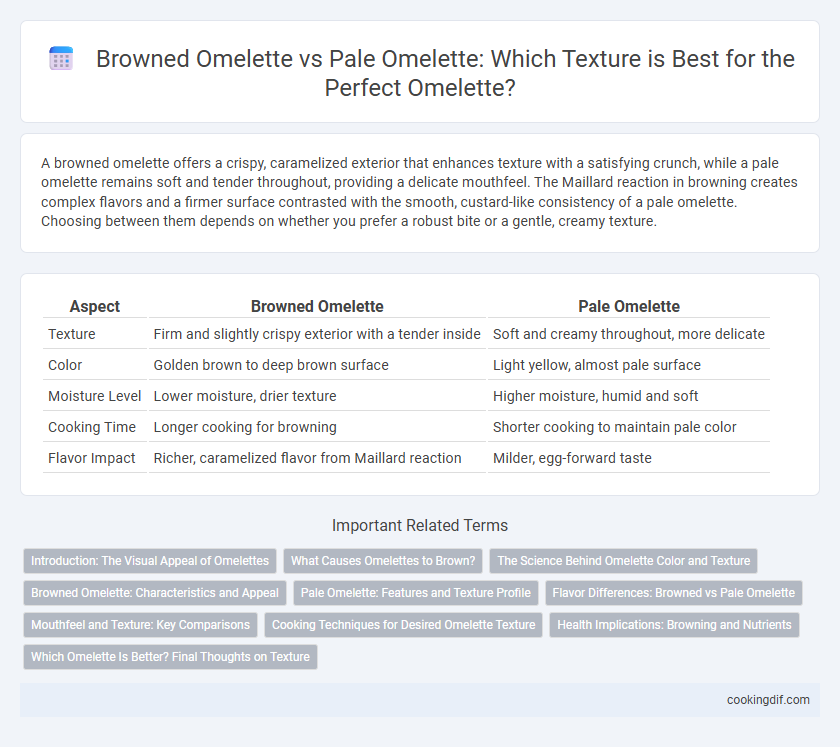A browned omelette offers a crispy, caramelized exterior that enhances texture with a satisfying crunch, while a pale omelette remains soft and tender throughout, providing a delicate mouthfeel. The Maillard reaction in browning creates complex flavors and a firmer surface contrasted with the smooth, custard-like consistency of a pale omelette. Choosing between them depends on whether you prefer a robust bite or a gentle, creamy texture.
Table of Comparison
| Aspect | Browned Omelette | Pale Omelette |
|---|---|---|
| Texture | Firm and slightly crispy exterior with a tender inside | Soft and creamy throughout, more delicate |
| Color | Golden brown to deep brown surface | Light yellow, almost pale surface |
| Moisture Level | Lower moisture, drier texture | Higher moisture, humid and soft |
| Cooking Time | Longer cooking for browning | Shorter cooking to maintain pale color |
| Flavor Impact | Richer, caramelized flavor from Maillard reaction | Milder, egg-forward taste |
Introduction: The Visual Appeal of Omelettes
A browned omelette offers a crispy exterior that contrasts with its creamy interior, enhancing the overall texture and mouthfeel. In contrast, a pale omelette maintains a soft, tender consistency with a smoother surface, appealing to those preferring delicate bites. The visual difference between the golden-brown hues and the light yellow tones often influences the perceived taste and texture before the first bite.
What Causes Omelettes to Brown?
Omelettes brown due to the Maillard reaction, a chemical process between amino acids and reducing sugars that occurs at higher temperatures, resulting in a richer flavor and firmer texture. A browned omelette tends to have a slightly crispy exterior, enhancing the mouthfeel, while a pale omelette remains soft and tender with a milder taste. Controlling heat and cooking time directly influences whether the omelette develops a golden-brown crust or stays pale and delicate.
The Science Behind Omelette Color and Texture
The browning of an omelette results from the Maillard reaction, where amino acids and reducing sugars react under heat, creating a complex flavor profile and a firmer, slightly crispy texture. In contrast, a pale omelette undergoes minimal Maillard reaction, retaining a softer, more delicate, and creamier texture due to lower heat exposure. Understanding the balance of heat and cooking time is crucial for controlling the omelette's color and texture, as higher temperatures produce a browned exterior while preserving a tender interior requires careful timing.
Browned Omelette: Characteristics and Appeal
A browned omelette offers a crispy exterior with a rich, caramelized flavor that enhances its sensory appeal, creating a satisfying contrast to its soft interior. The Maillard reaction during browning develops complex savory notes and an appealing golden-brown color that signals a well-cooked dish. This texture variation elevates the eating experience, making a browned omelette preferred by those who enjoy a combination of crunch and tenderness.
Pale Omelette: Features and Texture Profile
A pale omelette has a tender, custard-like texture with a smooth, moist surface, achieved by cooking at lower heat to prevent browning. Its delicate consistency highlights the eggs' natural creaminess, making it ideal for fillings and gentle flavors. Unlike browned omelettes, the pale variety remains soft and slightly airy without the crispy edges or caramelized notes.
Flavor Differences: Browned vs Pale Omelette
A browned omelette develops a rich, caramelized flavor due to the Maillard reaction, offering a slightly crispy texture that enhances savory notes. In contrast, a pale omelette retains a softer, creamier texture with a delicate, milder taste that highlights the eggs' natural sweetness. The flavor intensity and texture contrast between browned and pale omelettes significantly impact the overall eating experience, catering to different palate preferences.
Mouthfeel and Texture: Key Comparisons
Browned omelettes develop a slightly crisp exterior that enhances the mouthfeel with a satisfying contrast between the tender interior and caramelized surface. Pale omelettes offer a softer, more uniform texture, creating a delicate and smooth bite that emphasizes creaminess over crunch. The choice between browned and pale largely influences the sensory experience, balancing between a complex, layered texture and a tender, consistent softness.
Cooking Techniques for Desired Omelette Texture
A browned omelette develops a firmer, crispier exterior through higher heat and longer cooking time, enhancing flavor via Maillard reactions. In contrast, a pale omelette results from gentle cooking at lower temperatures, creating a soft, tender texture with a creamy interior. Mastering temperature control and cooking duration is essential to achieve the preferred omelette texture, whether crispy or delicate.
Health Implications: Browning and Nutrients
A browned omelette develops Maillard reactions that enhance flavor but may cause slight nutrient loss, particularly heat-sensitive vitamins like B-complex and folate. A pale omelette retains more of these nutrients due to gentler cooking, preserving better antioxidant levels and amino acid structures. Choosing between browned and pale omelettes impacts health by balancing nutrient retention with taste preference and digestibility.
Which Omelette Is Better? Final Thoughts on Texture
A browned omelette offers a crisp exterior that adds a satisfying contrast to its soft interior, enhancing the overall texture experience. In contrast, a pale omelette remains tender and fluffy throughout, appealing to those who prefer a delicate mouthfeel. Texture preference depends on individual taste, with browned omelettes providing a richer, more complex bite and pale omelettes delivering smooth softness.
Browned Omelette vs Pale Omelette for texture Infographic

 cookingdif.com
cookingdif.com